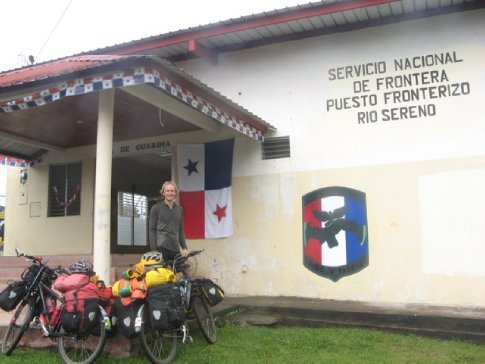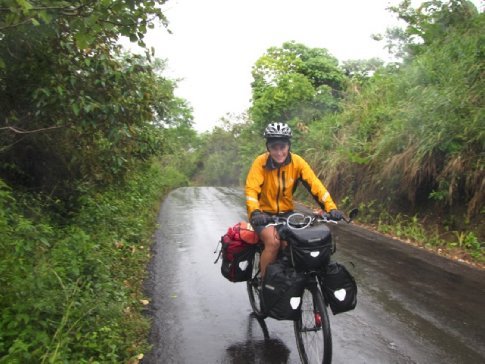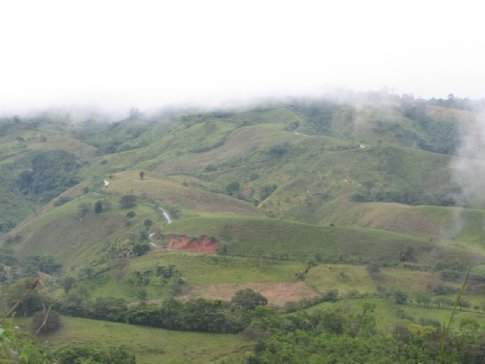We left you at the small border crossing into Panama in Rio Sereno.
After getting our exit stamp for Costa Rica, we enter the Panamanian border crossing.
We are the only people here, except then for the migration official and three Panamanian army officers. The migration officer tells us that Ali, being Australian, needs a tourist card to enter. Unfortunately the bank where this card has to be purchased is closed for three days, because of independence day a day earlier..... The border official suggests we ride down to Paso Canoas, the big international border crossing. We are not so happy with this idea, since we are already going to ride a long stretch of Interamericana further east and here is one of the few places where we can enjoy riding quiet mountain back roads... Our pleading that we have ridden uphill for two days just to get here doesn’t change a thing.
So, we walk back to the Costa Rican immigration office, where the official annuls our exit stamps. He advises us there is a shorter road to Paso Canoas, not on our map, and technically on Panamanian soil. But he says it will be fine. So a bit reluctantly since we are in Panama without Panama entry stamps, we take off on this road. It turns out to be a gorgeous ride, at least for the start of it, dead quiet road through coffee plantations, farms and green hills. Then it starts raining, not just a little, but the heavens open (later we see on television the whole area was subject to flooding). 
On our map it looks like we are going to descend from 1200 meters down to sea level. Also we are told by a few people that it will be ‘todo plano’ and ‘solo bajar’ (completely flat and only downhill). Just to spice things up a little we get some nasty 20 % climbs to test the limits of our riding ability. 
Dog tired we arrive in Paso Canoas to get new stamps and to ‘really’ enter Panama.
We decide to cheat a little and take a bus to David, and the next day on to Santiago, since we have to be in Panama city before the 11th of november, because the boat we have booked for Colombia is leaving that day.
Getting on the bus in David is a bit of a drama. It’s the end of the three day public holiday, and Panamanian holiday people are returning home en masse. By bus. The drivers and helpers of the smaller (and quicker) buses don’t want us to help getting our bikes on the roof of the bus, and we don’t want them to do this without our supervision. In the end we wait for three hours in line for the normal bigger bus, our bikes meshed up between bags but at least a friendly and helpful driver. Somehow a day in the bus and all the fuss around getting our things in and out is far more tiring than a days riding. But alas, we get some more miles down the road this time.
From Santiago we ride a few days on the Interamericana. This is the only option to get east. The scenery is gorgeous, and many times I think : ‘I wish there were some backroads through those beautiful hills’. But, the highway is safe, straight and fast.
Panama feels quite different to other Central American countries. Possibly more americanised than Costa Rica. Maybe it is because most towns we see are built along the highway, and none of them have any atmosphere. Just stretches of malls and motels and gas stations.

Here you see me in a ‘ride up bank’
There are some long stretches without any towns. Maybe all the smart rural Panamanians live away from the Interamericana. Although we have read they are a very urbanised people.
A nice experience we have happens the day before arriving in Panama city. We find ourselves tired of riding in the afternoon but no hotels in sight. Then suddenly we see a bomberos (fire station). In some countries cyclists can stay overnight on their premises, so we decide to try our luck. A few instants later we find ourselves camped in their ‘office’, some shelter, a toilet and a rustic outdoor shower...what more could we want!

Caesar and Coco are our friendly companeros for the night. They work 24-hour shifts every other day, eleven months of the year!

Riding into Panama city is an exciting day. The amount of traffic increases a lot, with lots of Chicken buses. We are both counting down the kilometers for a while, and tick 18.000 kilometers just before we finally see the bridge: Puente de las Americas.

Connecting the Northern and Southern American continents (not officially but geographically), this bridge crosses the Panama canal. It has a narrow footpath on the left, so we take our time to look at the canal, while the heavy traffic zooms past.

It feels like a real finish to a long ride through Central America.
We enter the city through the slums of Chorillo.
Then onto a wide bike path along an esplanade with views of skyscrapers and the Pacific Ocean.

We find a place to stay for a few nights to check out the city and rest up before our boat departure.
A bit lazy those days in the city we take a taxi to the Miraflores locks, north of town.
We had no idea how much is involved in the passage of the canal. Boats have to ascend and descend about 50 meters, over an 80 kilometer stretch. This is done by means of a number of locks. From above on a crazy hot platform we sweat and watch to see a few big boats go through the first set of locks. All the while a man downstairs keeps us visitors entertained telling facts and jokes through an intercom. He makes us ‘group applaud’ for the boats. Somehow I think the boat crew must be getting bored with that. The crew on board and the crowd on the platform wave to and fro.


There is also a good museum, with stories about the history of the canal.
On the 11th at 5 am we are picked up by jeep to drive to Carti. Unfortunately we don’t have enough time to ride this last stretch.
While in the jeep we are told they have actually upgraded the road in the last year. From the window we see possibly the nicest bit of jungle we have ever seen. Steep hills, occasionally some indigenous people walking on the road, and trees, trees, trees. And from the top of the hills a view of the San Blas Islands in fog and rain.

We have been riding through the tropics since april 2009, but we have only seen very small bits of ‘original’ rainforest. Most of the rain forest has been cut away. A lot of areas still look kind of ‘natural’ because there are trees and green grass, but they are often second growth forest and farmland.
This area is a comarca or autonomous territory inhabited by the Kuna indigenous people.The women have very striking faces and beautiful dresses and anklebands.

They live on the San Blas Islands and a stretch of land on the northern side of Panama, and tourists are only allowed on a small number of the islands. Non-Kuna people are not allowed to purchase property in the comarca. Maybe this is why the area appears still relatively intact.
From Carti we load the bikes on a panga, and are brought to the Stahlratte. The Stahlratte is a 1903 Schooner, and has been sailing Caribbean waters for the past 16 years.
We had heard so many positive stories about this boat and her captain, Ludwig, that we made a big effort to join her last sailing to Cartagena of this year.

On board we meet Ludwig, the German captain, and Roli, his tall and strong right hand man. On board are already 19 other passengers, 11 of which on 9 motorbikes, all heading to Argentina!

They are as amazed with our pace as we are with theirs.
We spent a day lazing at the San Blas Islands, a snorkel paradise, but on this rainy grey day a good day to do nothing but chill out on deck hearing stories from the motociclistas, enjoying some good food, and jumping in the water from a long rope.

There is some excitement in the air: we are going to Colombia!